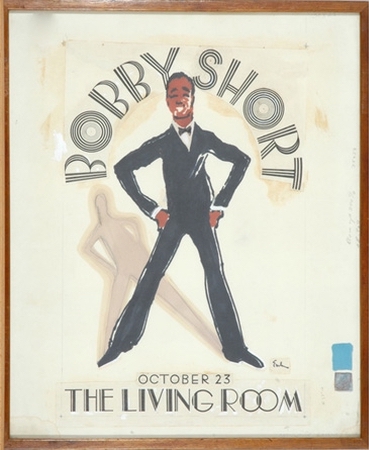
I just cannot stop thinking about this painting.
It is by fashion illustrator and creative director Joe Eula, and it’s huge, maybe the biggest work of his I’ve ever seen—because I’ve never been able to find images of the giant Eiffel Tower scrim he painted on the fly for the Battle of Versailles in 1973 after discovering the backdrops he’d made used inches instead of centimeters, and so they didn’t fit.
But the size only underscores the wtf-ness of the subject: these are life-sized monkeys at the bar, and lounging in the club chair under a disco ball [?] in the country house next to what looks like a roaring fire? And those monkeys, according to Doyle, the auction house that sold this painting in 2006, those “abstract monkey figures represent Bobby Short, Elsa Peretti, Mrs. Glenn Bernbaum and Joe Eula.”

Bobby Short, we know, of course. In fact, his friendship with my family, and the presences of Eula’s poster of him in my mom’s basement, was the first Google search that led me to this monkey business. [Turns out the original sketch for that poster sold at Doyle, too, for not much at all. I really wish I’d known. You out there? HMU!]
Of course, Short was friends with everybody, including Eula—who, like Elsa Peretti, was extremely close with Halston—and [Mr.] Glenn Bernbaum. Short might have been the only Black person who could regularly get a table at Bernbaum’s restaurant, Mortimer’s. But though I did a spit take and a doublecheck after seeing this painting, there very much was no Mrs. Glenn Bernbaum.
Bernbaum’s meanness, snobbishness, racism, alcoholism, and anti-Semitism, along with Short’s relentless, performative, anti-sensual charm, all stem from the same thing: the ingrained personal discomfort at the precarity of being gay and Jewish or Black among the ruling class of a systemically racist and homophobic society.
The Doyle auction included 42 lots of Eula material, which makes me think they were from his collection. Nothing else sheds any light on this painting, though. Was it a weekend visit of friends to Eula’s house in Hurley, NY? The late date, 1996, was not long before Bernbaum died. Eula died in 2004, and Short in 2005. Short’s own estate auction at Christie’s included large amounts of African art and furniture, as well as racist artifacts from the US Jim Crow era of his youth; I think he had a not-unsophisticated view of the implications of his closest friends depicting him—and them!—as monkeys, even if today it fees like All Monkeys Matter.
But where did this painting live? Who saw it? How did it come about? Did Glenn Bernbaum actually have quiet, goofy weekends with friends where he could just be? Elsa Peretti, the last monkey standing, died in 2021, so the chance for a firsthand account is gone. [few minutes later update: Perhaps Cathy Horyn, who wrote the book on Eula in 2014, and hung out at his Hurley house, knows something about this monkey painting business.]
